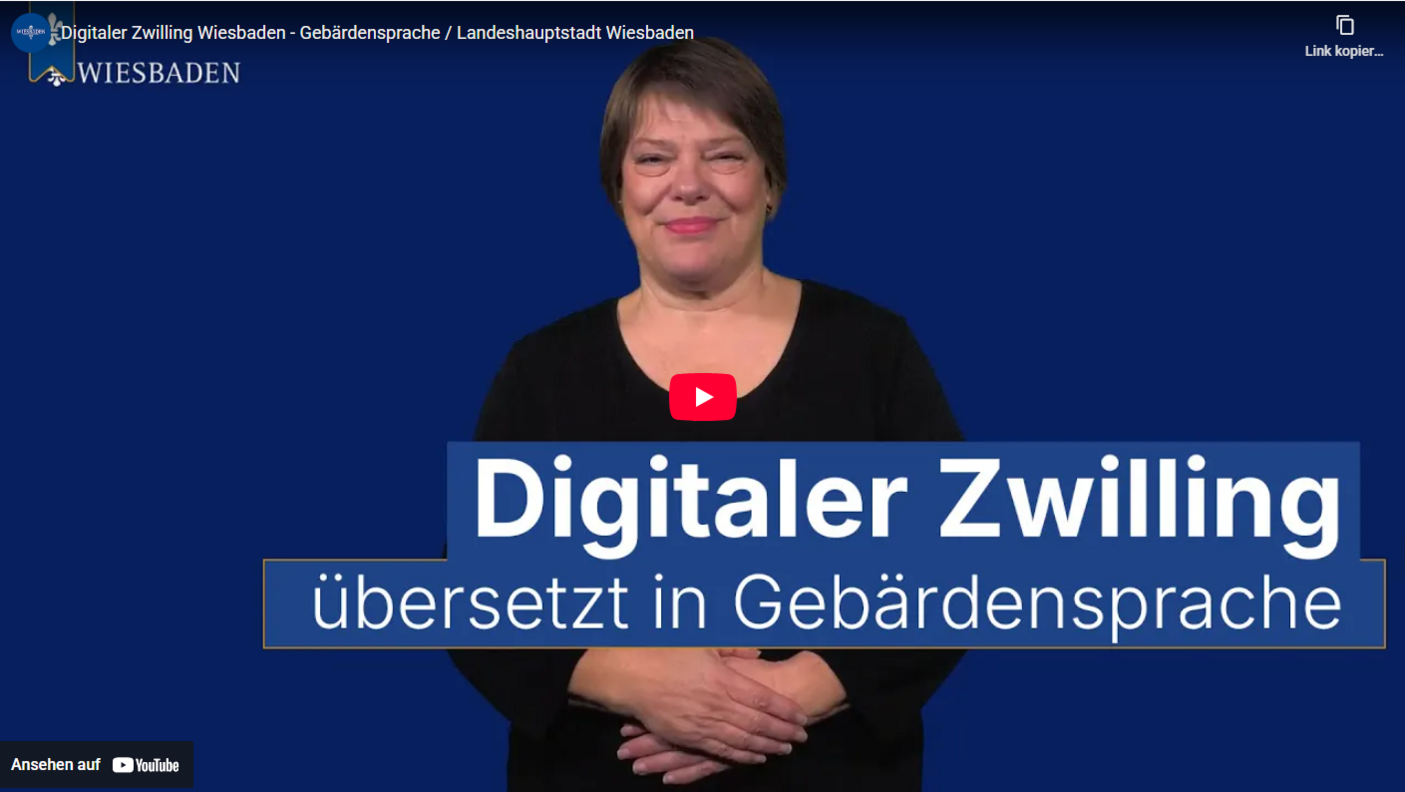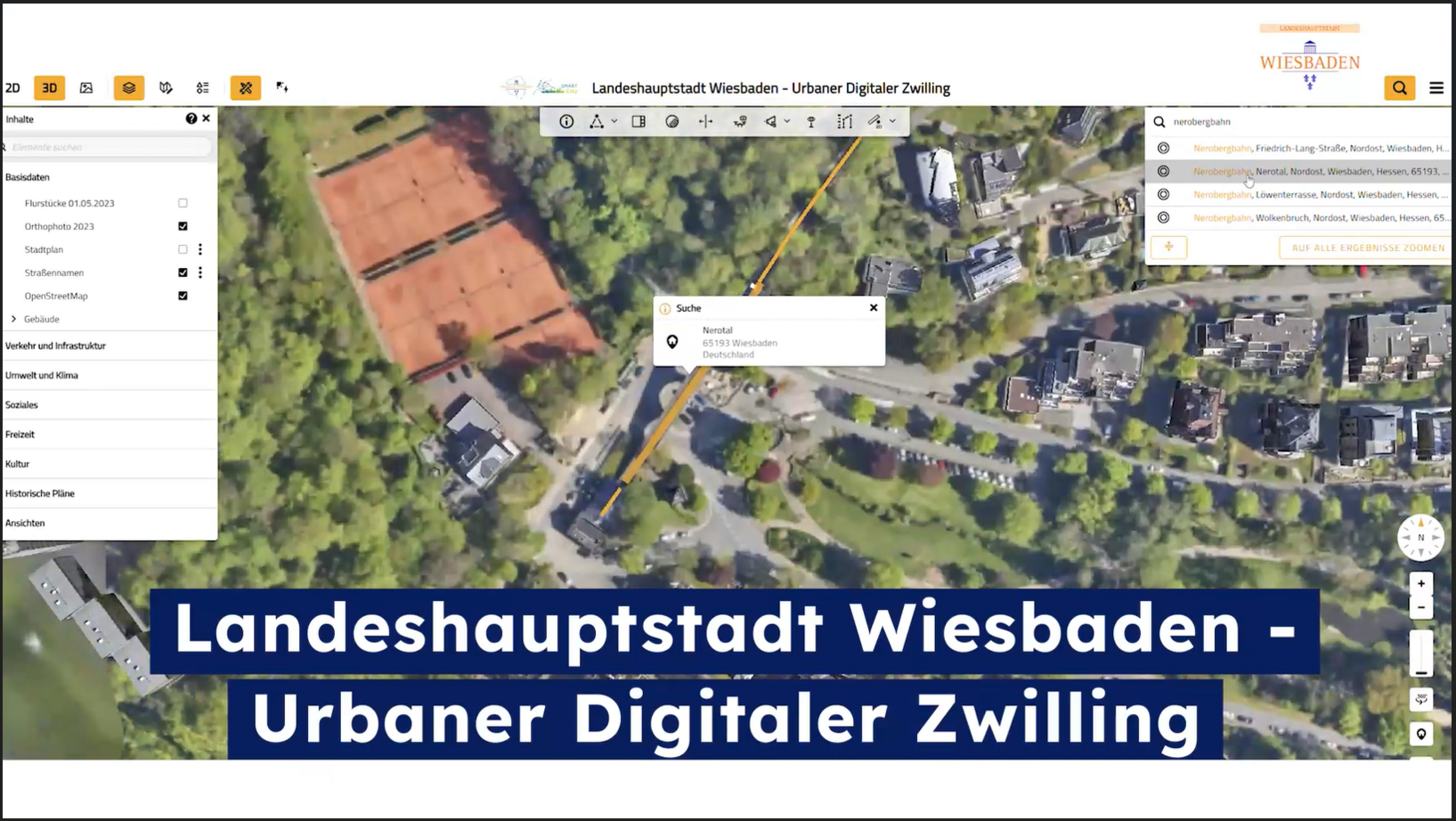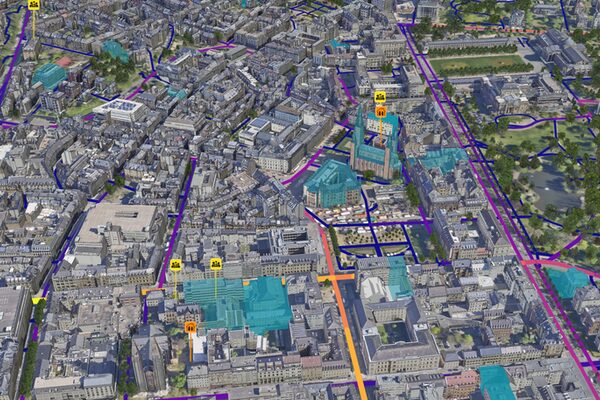Digital twin Wiesbaden
The first development stage of the Urban Digital Twin of the state capital Wiesbaden is now available.
The urban digital twin in sign language
In order to view the external content, you must enable it by clicking on the "Activate content" button. In doing so, the provider sets cookies and collects data on your usage behavior. You can revoke your consent at any time in the privacy settings (opens in a new tab) at https://www.wiesbaden.de/datenschutz.
The digital image of the state capital of Wiesbaden for analyses, modeling and simulations is more than just an interactive city map. The Urban Digital Twin (UDZ) (opens in a new tab) digitally maps the city in all its complexity and provides a sound basis for analyses, planning and participation processes. The first version is now available for public use.
Digital twin
In order to view the external content, you must enable it by clicking on the "Activate content" button. In doing so, the provider sets cookies and collects data on your usage behavior. You can revoke your consent at any time in the privacy settings (opens in a new tab) at https://www.wiesbaden.de/datenschutz.
Structured information for well-founded decisions
Urban digital twins (UDZ) digitally map entire cities, districts, objects and areas of a city, linking different data layers to create a holistic, virtual image of reality. They can contain both static information (on individual buildings, objects, areas or infrastructure) and dynamic data (such as air quality, traffic situation, parking garage utilization and so on).
Success factor database
High-quality data forms the foundation of this digital image. They enable the visualization of complex relationships in a city - for example, how buildings, population, traffic or environmental factors can influence each other. These visualizations help both experts and the general public to better understand complex urban processes and interrelationships.
Digital twins can be used to simulate "what-if" scenarios, for example for urban development, traffic planning or climate adaptation. Planners can evaluate the effects of various measures in advance and make more informed decisions.
Why is the UDZ of the state capital Wiesbaden being made publicly accessible at an early stage of development?
With the digital twin, Wiesbaden is launching an innovative planning tool from which politicians, administration and urban society can benefit equally.
However, the version that is now available is not final. Wiesbaden is deliberately focusing on transparency and participation - instead of a "black box". Citizens, scientists and businesses now have the opportunity to actively provide feedback, contribute their own ideas or even contribute to further development with their own data and applications. In this way, digital participation is strengthened and the project is further developed together with citizens in their interests.
Suggestions, criticism and own ideas can be contributed directly and flow into the further process.
The project initiators are confident that the diversity of perspectives from urban society will help to ensure that the digital twin is designed in a practical and needs-oriented manner.
The digital twin will be developed step by step: It currently includes 2D and 3D views, oblique aerial images, 360° visual analyses and simulations of shadow impact and flooding. Further data and models from the areas of climate, mobility and energy supply will follow in the future.
The project managers anticipate an initial development period of at least five years, while the strategic use and further development is planned for a period of 20 to 30 years.
What distinguishes the Urban Digital Twin from other well-known map and navigation services?
The Urban Digital Twin of the state capital Wiesbaden fulfills a different and more comprehensive purpose: map and navigation services such as Google Maps help users to search for exact locations, find their way around, plan routes and obtain information about places, businesses and sights. The Urban Digital Twin pursues other goals: The digital image of our city is to be developed as a dynamic, intelligent planning tool that supports fact-based decision-making in Wiesbaden. In addition to a map-based representation of important locations for citizens, analysis data, models and simulation tools are to be successively integrated and optimized in order to better predict complex urban developments. The internal development team examines on a case-by-case basis which data and information are useful for this and in what form they need to be integrated. With the UDZ, the City of Wiesbaden is developing a powerful tool, which for these reasons is not necessarily designed for the pocket.
Smart City head of department Maral Koohestanian:
"With the Urban Digital Twin, we are setting a milestone for a sustainable city administration. It is more than just an interactive city map in which a wide range of municipal data can be brought together, visualized and analysed. It serves as the basis for smart city administration. The planning tool supports sustainable urban development, allowing us to take a holistic view of the impact of measures on the environment, mobility and quality of life and manage them in a more targeted manner."
How do Wiesbaden's administration and politics benefit from the Urban Digital Twin?
Future topics - such as sustainable and social urban development, climate protection and climate adaptation or future-oriented mobility - can be tackled in the best possible way with the digital twin. The virtual representation makes it possible to better assess the impact of changes on future implementation projects. The better the data basis, the better reality can be depicted and the more accurately simulations can be calculated. On this basis, concrete improvements can be examined more quickly, evidence-based decisions can be made in the administration, in the city council or in the local advisory council and then implemented for the benefit of urban society.
What added value does the Urban Digital Twin bring for citizens?
An urban digital twin promotes citizen participation, improves access to information and helps to make the city more liveable and sustainable. Citizens receive transparent access to up-to-date information about infrastructure, mobility services, as well as contact and advice centers or cultural institutions.
Does the urban digital twin also have advantages for the local economy?
The digital twin also opens up new opportunities for the local economy. Companies can use the platform to carry out location analyses, forecast infrastructure requirements and develop innovative smart city solutions. This technology can be a catalyst for economic growth and innovation in our city.
Andreas Kowol, Head of Civil Engineering and Transport:
"The Civil Engineering and Surveying Office has been collecting and processing geodata for decades. Wiesbaden is now making a big leap forward in terms of the graphic processing and visualization of this information. The new interactive map gives every citizen access to exciting representations of our city, many of them in 3D."
A joint project with many participants
The Wiesbaden digital twin is being set up and further developed in close cooperation between the city surveying department in the Civil Engineering and Surveying Office, the Smart City department and the city's specialist departments. This also involves close cooperation with other partners of the city group. The implementation partner is the company virtualcitysystems GmbH.
The Urban Digital Twin is financed by a combination of public funding from the state of Hesse (opens in a new tab) and municipal budget funds.
Now it's your turn!
Do you have any new ideas or suggestions for us regarding the digital twin? We would be delighted if you could contact us with specific points of contact via smartcitywiesbadende and/or geodatenwiesbadende.


